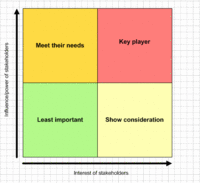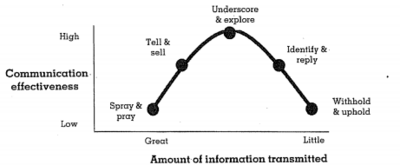Communication and Managing People in Change Projects
| Line 12: | Line 12: | ||
'''Stakeholder mapping''' | '''Stakeholder mapping''' | ||
| − | + | [[File:Stakeholder_grid_s150918.gif|200px|thumb|right|Stakeholder grid]] | |
A stakeholder is any individual, group or organization that can affect, be affected by, or perceive itself to be affected by a programme. The first step is ‘stakeholder brainstorm’ which involves identifying all the stakeholders who have an interest or influence over the outcome of the change project. The second step involved assessing how much power and influence each stakeholder has. The third step involved assessing each stakeholder’s attitude towards the proposed change. | A stakeholder is any individual, group or organization that can affect, be affected by, or perceive itself to be affected by a programme. The first step is ‘stakeholder brainstorm’ which involves identifying all the stakeholders who have an interest or influence over the outcome of the change project. The second step involved assessing how much power and influence each stakeholder has. The third step involved assessing each stakeholder’s attitude towards the proposed change. | ||
| − | |||
| − | ''' | + | '''Influencing stakeholders to support the change''' |
| − | Influencing stakeholders to support the change''' | + | |
Map the different stakeholders on the stakeholder grid as seen in the image. | Map the different stakeholders on the stakeholder grid as seen in the image. | ||
Win the support of those who oppose the change and who have the power to influence the outcome. | Win the support of those who oppose the change and who have the power to influence the outcome. | ||
| Line 30: | Line 28: | ||
• How frequent is the communication required? | • How frequent is the communication required? | ||
• What needs to be communicated? (Reports, Meeting minutes, Details or Summary) | • What needs to be communicated? (Reports, Meeting minutes, Details or Summary) | ||
| + | |||
Besides the Stakeholder analysis, two other tools that can be used by a project manager for effective communication are: | Besides the Stakeholder analysis, two other tools that can be used by a project manager for effective communication are: | ||
| + | [[File:ishikawa.png|200px|thumb|right|Ishikawa Diagram]] | ||
'''The Ishikawa diagram''' | '''The Ishikawa diagram''' | ||
| + | |||
Each bone is labelled with a problem and then it is broken down further by looking at the causes for each problem. This tool is simple but effective at getting to the real issue quickly.//More to come | Each bone is labelled with a problem and then it is broken down further by looking at the causes for each problem. This tool is simple but effective at getting to the real issue quickly.//More to come | ||
| − | |||
'''Using a RACI chart''' | '''Using a RACI chart''' | ||
| Line 45: | Line 45: | ||
== Clampitt’s five communication strategies == | == Clampitt’s five communication strategies == | ||
| + | [[File:Clampitt.png|400px|thumb|right|Clampitt's Communication Strategies]] | ||
| − | |||
'''Spray and Pray:''' The managers shower employees with all kinds of information both relevant and irrelevant and hope they will feel informed and have access to all the information they need. Managers hope that employees can see the difference between important and general information. This communication strategy gives employees a chance to take part in improving the decision making. | '''Spray and Pray:''' The managers shower employees with all kinds of information both relevant and irrelevant and hope they will feel informed and have access to all the information they need. Managers hope that employees can see the difference between important and general information. This communication strategy gives employees a chance to take part in improving the decision making. | ||
Revision as of 10:57, 18 September 2016
//Work in Progress//
Project managers have to be able to effectively manage projects with respect to time, scope and cost but a greater challenge is to manage the project team. Human behaviour is an important factor that determines the success and timely delivery of a project. Project Managers are faced with situations where changes to the scope of a project are introduced, for instance, requirements from clients change and then these changes have to be included, even during the last stages of the project. A project in itself brings about change. There will always be, people for and against the change. Not everybody can be satisfied and therefore, managers need to have the ability to communicate effectively and through active stakeholder management, be able to lead people towards the goals of the project and minimize or avoid any form of resistance from employees.
The importance of communication in project management cannot be stressed enough. Many projects fail due to the lack of communication. Agile framework is currently used by many organisations, which allow the client to make changes to the requirements even at the final stages of a project. Therefore without an effective approach to manage human behavior towards change, many projects will fail. Communication being the key to successful change projects, managers need to make use of effective methods. Clampitt’s five communication strategies will be analysed and can be used by project managers as an effective approach to communicate the project goals to the team. Based on stakeholder mapping, different communication strategies can be adopted depending on the power and influence of a stakeholder in the outcome of a project. Behavior such as resistance to change and conflicts, if not dealt with effectively, becomes a setback to the delivery of the project. The project team must be motivated and driven in the right direction and a conducive environment has to be created in order for people to work together. Therefore managers must be able to identify sources of resistance from the employees and manage them effectively. The different ways to avoid or minimize resistance will be discussed. The different stages of psychological reactions of employees need to be understood to develop ways to avoid or minimize resistance from project employees. This article focuses on enabling managers to communicate effectively and also create awareness about the sources of resistance among people and ways to minimise resistance to change.
Contents |
Effective Communication
PMI announced that two out of five projects do not meet their originally set goals and one out of five projects fail due to ineffective communication. It is not sufficient for project managers to be good communicators but have to communicate in ways that the whole organization benefits from it. Successful projects depend on effective communication methods used from the initial to the final stages of the project.
Different stakeholders have different stakes in a project and therefore, the method of communication must be chosen depending on the power and influence of the stakeholder on the outcome of the project. Stakeholder analysis is essential for a project manager to establish an effective communication plan.
Stakeholder mapping
A stakeholder is any individual, group or organization that can affect, be affected by, or perceive itself to be affected by a programme. The first step is ‘stakeholder brainstorm’ which involves identifying all the stakeholders who have an interest or influence over the outcome of the change project. The second step involved assessing how much power and influence each stakeholder has. The third step involved assessing each stakeholder’s attitude towards the proposed change.
Influencing stakeholders to support the change
Map the different stakeholders on the stakeholder grid as seen in the image.
Win the support of those who oppose the change and who have the power to influence the outcome.
Increase the influence of those stakeholders who are already supportive.
Reduce the influence of powerful blockers
Build a coalition of supportive stakeholders who will be prepared to work together to support the change
‘Change is the only constant in life’. Clients require changes even at the final stages of a project. An effective communication plan is one that considers all the changes throughout the project and makes sure that all the stakeholders are fully updated with the progress of the project.
The following questions will have to be considered by a project manager before creating the communication plan:
• What kind of communication is required? (Management Meetings, Team Meetings, Management Reporting)
• Who needs to be communicated with? (Stakeholder Mapping)
• How frequent is the communication required?
• What needs to be communicated? (Reports, Meeting minutes, Details or Summary)
Besides the Stakeholder analysis, two other tools that can be used by a project manager for effective communication are:
The Ishikawa diagram
Each bone is labelled with a problem and then it is broken down further by looking at the causes for each problem. This tool is simple but effective at getting to the real issue quickly.//More to come
Using a RACI chart
//WIP
//Image
Clampitt’s five communication strategies
Spray and Pray: The managers shower employees with all kinds of information both relevant and irrelevant and hope they will feel informed and have access to all the information they need. Managers hope that employees can see the difference between important and general information. This communication strategy gives employees a chance to take part in improving the decision making.
Tell and Sell: The managers are not allowed to give all kinds of information to the employees. Information exchanged is very limited and related to the change. The managers tell the employees first about the core issues and then try to sell them the wisdom of their approach to managing them.
Underscore and Explore: Employees have opportunities to share their ideas and managers consider employees’ ideas to improve the change process. Here the managers focus on few clear messages related to the change, same as “tell & sell” approach. But here the managers give the employees the freedom they need to explore the implications of these issues. Those who adopt this approach are concerned not only with developing a few core messages but also listen for misunderstandings and unrecognised obstacles.
Identify and Reply: The main focus is on employees’ problems. It requires a lot of listening in order to identify and respond to these issues. In this type of communication, too much sharing or exchange of information is not possible, because the process is not fully in control of the managers. There might be some employees who are not willing to ask for information or managers don’t feel it is necessary to share.
Withhold and uphold: The managers withhold information until it is necessary and as long as possible. Secrecy and control are the keywords in this approach. Some of those who adopt this strategy assume that information is power and they are reluctant to share it with anyone. Spray & pray is the opposite of this approach. There is lack of open and constructive communication.
Reasons for people to resist change
Parochial Self-interest: Stakeholders put their interests in front of the organisation’s and think that change will cause them to lose something of value. Employees analyse the effects that the change might have on them personally in terms of amount of work, their career prospects, power and status, and the prestige of the groups to which they belong. Managers often fail to see that employees consider change to affect their personal growth.
Misunderstanding and Lack of trust: This situation can occur when stakeholders or employees do not trust the manager or the change initiator and due to this, people misunderstand that there will be no gain out of the change.
Different assessments: This kind of resistance can be seen mainly from an external stakeholder where they assess the situation differently from that of the change manager and argue that maybe the change initiator does not have enough data or that external stakeholders are not taken into account.
Low tolerance for change: Some members could be limited in their ability to change. They sometimes require a transition period and are so habituated to the old working methods that they are emotionally unwilling to change.These members may require a grieving phase similar to that which happens when someone loses their loved one.
Ways to minimize resistance
Education and persuasion Educate people about the need for change. This method is based on the assumption that people are rational and the benefits of the change to the organization will be seen by them when facts are presented. Persuasive strategies also work well when the level of motivation to change is low. Repeated advertising and stressing on the positive outcomes of the change can motivate organizational members and increase commitment. Another way of persuasion is by making the employees feel unsatisfied with the currrent state of affairs by reminding them of the better state that the change project can take them to.
Involvement By allowing the participation of the stakeholders and employyees in collection and analysis of data, it makes room for more trust from the employees about the change rather than presenting them with facts of the need for the change. Nadler(1993) suggests that people who undergo change process tend to feel they are victims to change and hence through their excessive involvement in the change process, they are less likely to cry victim. Organisational members who do not participate in the initial stages of change diagnosis are likely to be less productive in the initial stages of implementation as they take longer to understand and accept the change.
Facilitate and support Change in itself can be alarming to some members, therefore Kotter and Schlesinger (1979) suggest that managers might need to sometimes just listen and provide emotional support to their employees. Managers can also provide training sessions or ask them to take some time-off after a challenging period. It would be the right way to support them to help them let go of the current state and transition to the new state.
Negotiation and agreement A reward to those who are unlikely to agree to the change proposal could a direct method of getting them on board and negotiating certain agreements with someone who is going to lose out on some value for sure would be an easy way to prevent resistance. The downside to this approach is that members who do not oppose to the proposal may consider this as an opportunity on being rewarded.
Manipulation and co-option Some members can be influenced into the change by bombarding them with messages repeatedly and persuasion. Assigning a position or a role in the design or implementation of the change can also gain their loyalty to the change.
Explicit and implicit coercion The use of authority to coerce employees to be on board the change process could be a way of avoiding resistance though it might earn resentment from the organization members. This might get the employees to follow the change, but their commitment and motivation would be low. Power can be used in situations where the change proposal is not suitable to the target group and the organization needs to act fast.


